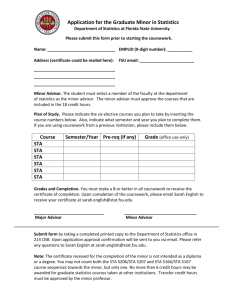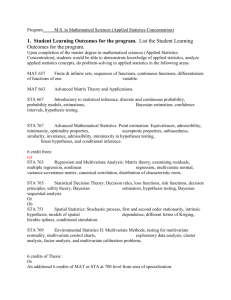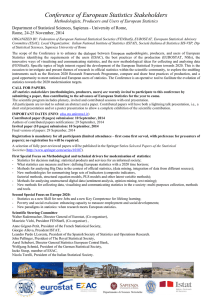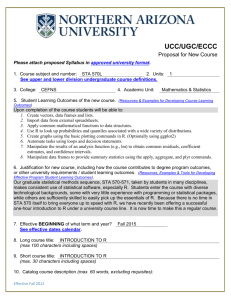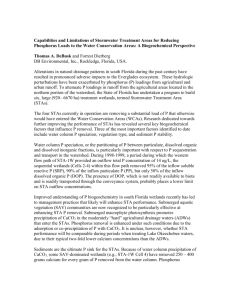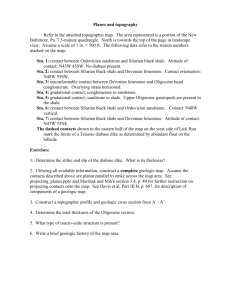Packet-Level Channel Switching in Multichannel
advertisement
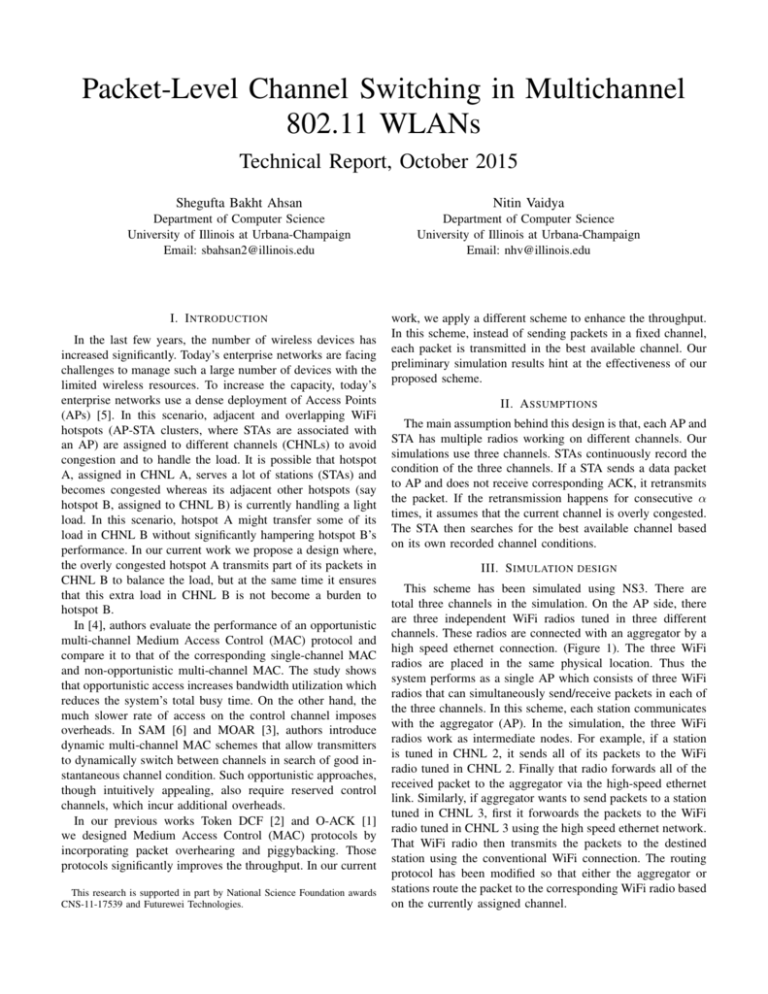
Packet-Level Channel Switching in Multichannel 802.11 WLANs Technical Report, October 2015 Shegufta Bakht Ahsan Nitin Vaidya Department of Computer Science University of Illinois at Urbana-Champaign Email: sbahsan2@illinois.edu Department of Computer Science University of Illinois at Urbana-Champaign Email: nhv@illinois.edu I. I NTRODUCTION In the last few years, the number of wireless devices has increased significantly. Today’s enterprise networks are facing challenges to manage such a large number of devices with the limited wireless resources. To increase the capacity, today’s enterprise networks use a dense deployment of Access Points (APs) [5]. In this scenario, adjacent and overlapping WiFi hotspots (AP-STA clusters, where STAs are associated with an AP) are assigned to different channels (CHNLs) to avoid congestion and to handle the load. It is possible that hotspot A, assigned in CHNL A, serves a lot of stations (STAs) and becomes congested whereas its adjacent other hotspots (say hotspot B, assigned to CHNL B) is currently handling a light load. In this scenario, hotspot A might transfer some of its load in CHNL B without significantly hampering hotspot B’s performance. In our current work we propose a design where, the overly congested hotspot A transmits part of its packets in CHNL B to balance the load, but at the same time it ensures that this extra load in CHNL B is not become a burden to hotspot B. In [4], authors evaluate the performance of an opportunistic multi-channel Medium Access Control (MAC) protocol and compare it to that of the corresponding single-channel MAC and non-opportunistic multi-channel MAC. The study shows that opportunistic access increases bandwidth utilization which reduces the system’s total busy time. On the other hand, the much slower rate of access on the control channel imposes overheads. In SAM [6] and MOAR [3], authors introduce dynamic multi-channel MAC schemes that allow transmitters to dynamically switch between channels in search of good instantaneous channel condition. Such opportunistic approaches, though intuitively appealing, also require reserved control channels, which incur additional overheads. In our previous works Token DCF [2] and O-ACK [1] we designed Medium Access Control (MAC) protocols by incorporating packet overhearing and piggybacking. Those protocols significantly improves the throughput. In our current This research is supported in part by National Science Foundation awards CNS-11-17539 and Futurewei Technologies. work, we apply a different scheme to enhance the throughput. In this scheme, instead of sending packets in a fixed channel, each packet is transmitted in the best available channel. Our preliminary simulation results hint at the effectiveness of our proposed scheme. II. A SSUMPTIONS The main assumption behind this design is that, each AP and STA has multiple radios working on different channels. Our simulations use three channels. STAs continuously record the condition of the three channels. If a STA sends a data packet to AP and does not receive corresponding ACK, it retransmits the packet. If the retransmission happens for consecutive α times, it assumes that the current channel is overly congested. The STA then searches for the best available channel based on its own recorded channel conditions. III. S IMULATION DESIGN This scheme has been simulated using NS3. There are total three channels in the simulation. On the AP side, there are three independent WiFi radios tuned in three different channels. These radios are connected with an aggregator by a high speed ethernet connection. (Figure 1). The three WiFi radios are placed in the same physical location. Thus the system performs as a single AP which consists of three WiFi radios that can simultaneously send/receive packets in each of the three channels. In this scheme, each station communicates with the aggregator (AP). In the simulation, the three WiFi radios work as intermediate nodes. For example, if a station is tuned in CHNL 2, it sends all of its packets to the WiFi radio tuned in CHNL 2. Finally that radio forwards all of the received packet to the aggregator via the high-speed ethernet link. Similarly, if aggregator wants to send packets to a station tuned in CHNL 3, first it forwoards the packets to the WiFi radio tuned in CHNL 3 using the high speed ethernet network. That WiFi radio then transmits the packets to the destined station using the conventional WiFi connection. The routing protocol has been modified so that either the aggregator or stations route the packet to the corresponding WiFi radio based on the currently assigned channel. Algorithm 1 Channel selection procedure currentChannelTxPwr = H.currentChnlTxPwr threshold = currentChannelTxPwr/2 L = H.channelsWithTxPowerLessThan(threshold) if L is not empty then return channel from L with lowest Tx Power else return current channel 8: end if 1: 2: 3: 4: 5: 6: 7: Fig. 1: Design of an AP with three different working radios operating in three different channels. IV. P ROCEDURE In this scheme, each AP is equipped with three independent WiFi radios each of them are tuned in three different channels. In this procedure STAs take decision about changing the channel. Though they use only the currently assigned channel to send/receive packet, it is assumed that they can also sense the power level of the other channels. Thus an STA continuously monitors the received power level in each channel. This information is continuously stored in the history H (Figure 2). The history is maintained for last ∆ duration; any data older than ∆ is overwritten by new data. Each STA has a module called Channel Manager which uses this history H to select the best channel. Fig. 2: History H at time t, maintained by an STA. The Gray boxes denote the received packets in three different channels. Information stored before time (t − ∆) are removed from H. The total received power during the ∆ window is the sum of the received power of packets that are received in this window. For example, in the case of CHNL 1, total 3 packets fall inside the ∆ window. Hence the received power during this time is the summation of the individual received power of these three packets. In this figure, during the last ∆ duration, received power of CHNL 1 > CHNL 2 > CHNL 3. It indicates that transmission rate in CHNL 3 is possibly less than the other two channels, hence the Channel Manager might shift some of the traffics to CHNL 3. When an STA is first connected to an AP, it is assigned to an initial channel, which is the primary channel for the AP-STA cluster. If the primary channel is not congested, STA continues transmitting packet in this channel. On the other hand, if STA does not receive MAC layer acknowledgement (ACK) from AP within a predefined time, it assumes that the packet has been lost, hence retransmits the packet and waits for a new ACK. If even this ACK is not received, the STA retransmits the packet again. In our scheme, if an STA does α consecutively retransmissions, it assumes that the channel is overly congested. Therefore, at current time t, the Channel Manager starts looking for a better channel. Channel Manager sets a threshold which is half of the received power in the current channel during [t − ∆, t]. Channel Manager then primarily selects all the channel from H, where the received power during [t − ∆, t] is less than the threshold. Among those channels, it pick a channel with the lowest received power level during [t − ∆, t] (Algorithm 1). To prevent oscillation, each STA is allowed to change channel only once during γ duration. In an AP-STA cluster when aggregator sends packets to a station (say STA 1, currently assigned to CHNL 1), the packets are first received by the corresponding WiFi radio (in this example WiFi radio 1, tuned in CHNL 1) and stored in its queue. STA 1 might change its channel to some other channel (say CHNL 2) before the transmission of all the packets stored in WiFi radio 1 completes. Once STA 1 tunes itself to CHNL 2, it can not hear from WiFi radio 1 ( which transmits in CHNL 1), hence all the pending packets from WiFi radio 1 to STA 1 get lost, which eventually trigger a chain of MAC layer re-transmissions. This problem has been handled in our simulation. When STA 1 changes its channel from CHNL 1 to CHNL 2, it triggers an event in the simulation, which transfers all the relevant packets stored in WiFi radio 1 to WiFi radio 2 via the high speed ethernet connection. Though this problem is handled in the simulation by triggering an event, the solution is not realistic. To make it more realistic, STAs can send direct/piggybacked signal to AP about its channel change. After receiving the signal, the WiFi radio assigned to the old channel transfers relevant packets to the WiFi radio assigned to the newer channel. This scheme is not implemented in our current simulation. Table I shows the simulation parameters used in this simulation. V. S IMULATION R ESULT This section presents some preliminary results of our simulation. In this simulation we have used three sets of partially overlapped AP-STA clusters, each of them are assigned to three different primary channels (Figure 3). In our simulation the transmission range of each AP is set to 20 meters. There TABLE I: Simulation Parameters Wifi Standard Tx range Frequency Band Data Rate RTS/CTS α ∆ γ 802.11a 20 meter 5GHz 54Mbps Disabled 2 5 ms 10 ms TABLE II: Flow details in a single AP-STA cluster. There are total 3 such clusters in the simulation (Figure 3), each of this clusters has 5 flows. In each cluster, the AP is associated with three STAs which are referred in this table as STA 1, STA 2 and STA 3 respectively. Flow 1 2 3 4 5 Sender STA 1 AP STA 2 AP AP Receiver AP STA 1 AP STA 2 STA 3 Duration 240 sec 240 sec 180 sec 180 sec 120 sec Rate 1M bps 1M bps 15M bps 15M bps 35M bps Fig. 4: Aggregate throughput in different AP-STA clusters in two different scenario. load type low low medium medium high are three stations in each AP-STA cluster. The stations are placed randomly within AP’s transmission range. Fig. 3: Three AP-STA clusters. Here each AP is a combination of the aggregator and three WiFi radios, which are not shown individually. AP1, AP2 and AP3 are initially assigned to CHNL 1, 2 and 3 respectively. STA 11, 12 and 13 are associated with AP1, STA 21, 22 and 23 are associated with AP2 and STA 31, 32 and 33 are associated with AP3. The total simulation time is 500 seconds. Table II shows the flow details in each AP-STA cluster. There are 5 flows in each clusters, thus the total number flow in the simulation is 15. All of the flows are UDP. The flow pattern of each of the three AP-STA clusters are identical. In each AP-STA cluster, the starting time of each flows are randomly selected. In the first simulation, the channel selection scheme was turned off. Hence, during the whole simulation, each APSTA clusters communicate using the initially assigned channel. The channel selection scheme was turned on in the second simulation where if STAs detect congestion, they search for Fig. 5: Retransmission count in two different scenario. a better channel. Figure 4 shows the throughput comparison between these two simulations. In the first scheme, the average throughput is 23.9 Mbps whereas in the second scheme it has been increased to 28.1 Mbps. Figure 5 shows the retransmission count in each of these two scenarios. In the first scheme, every AP-STA cluster transmits using the initially assigned channel, which creates congestion and leads to packet loss and retransmission. In the second scheme, STAs can select channel. For example, if AP-STA cluster 1 (primarily assigned to CHNL 1) gets congested and if at that time the second cluster (primarily assigned to CHNL 2) faces very low load (for example Flow 1 or 2 in Table II), some STA of Cluster 1 can start transmitting their packet in CHNL 2. Thus the channels are selected in packet level granularity, which opportunistically increases the throughput and reduce the retransmission. VI. D ISCUSSION AND C ONCLUSION The preliminary results suggest that the idea of channel switching on packet-level granularity is promising. In current simulation, STAs depend on their own local information to select best channel. To make the channel selection scheme more accurate, STAs might also collect information from the AP, which is not implemented in our current simulation. We assume that received power is same for each packet which is not true in real scenario. For the same type of packet, if the transmitter is nearby, the receiver will record much higher power. Instead of comparing channels by the received power, it can be compared based on the percentage of the total silent time (when the received signal is below the carrier sense threshold) over the ∆ time. R EFERENCES [1] S. B. Ahsan and N. Vaidya, “O-ack: An adaptive wireless mac protocol exploiting opportunistic token-passing and ack piggybacking.” LCN, 2015. [2] G. Hosseinabadi and N. H. Vaidya, “Token-dcf: An opportunistic mac protocol for wireless networks,” in COMSNETS, 2013, pp. 1–9. [3] V. Kanodia, A. Sabharwal, and E. W. Knightly, “MOAR: A multi-channel opportunistic auto-rate media access protocol for ad hoc networks,” in 1st International Conference on Broadband Networks (BROADNETS 2004), 25-29 October 2004, San Jose, CA, USA, 2004, pp. 600–610. [Online]. Available: http://dx.doi.org/10.1109/BROADNETS.2004.46 [4] Y. Liu, M. Liu, and J. Deng, “Evaluating opportunistic multi-channel mac: Is diversity gain worth the pain?” vol. 31, no. 11, November 2013, pp. 2301–2311. [5] R. Murty, J. Padhye, R. Chandra, A. Wolman, and B. Zill, “Designing high performance enterprise wi-fi networks,” in Networked Systems Design Implementation (NSDI). USENIX, April 2008. [Online]. Available: http://research.microsoft.com/apps/pubs/default.aspx?id=73427 [6] K. Tan, H. Liu, J. Fang, W. Wang, J. Zhang, M. Chen, and G. M. Voelker, “Sam: Enabling practical spatial multiple access in wireless lan,” in The 15th Annual International Conference on Mobile Computing and Networking (ACM Mobicom2009), Beijing, China. Association for Computing Machinery, Inc., September 2009. [Online]. Available: http://research.microsoft.com/apps/pubs/default.aspx?id=101535
